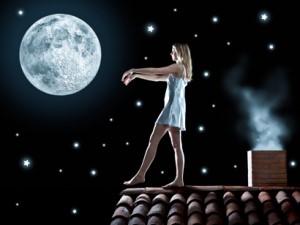We all know that sleepwalking and other sleep-related behaviors are common in children. However, what is not commonly appreciated is that these may persist or begin in adulthood. It is estimated that about 2% of the adult population exhibits parasomnias. Parasomnias are undesirable behaviors or experiences arising out of or during sleep.
The unpleasant consequences of these behaviors are extensive–ranging from self-inflicted injury to violent behaviors–sometimes resulting in injury to family members or strangers. There are well-documented examples of individuals falling down stairs, driving cars, and even exhibiting sexually related behaviors while asleep.
The majority of these parasomnias are referred to as disorders of arousal. The prime examples being sleepwalking, confusional arousals (sleep drunkenness), and sleep terrors. Essentially, the individual is manifesting complex behaviors without conscious awareness. It would appear that there are areas in the lower regions of the brain, such as the brainstem, that can generate both motor and primitive risk/reward behaviors with little or no involvement of higher cortical centers. This in essence is believed to be the basis of these parasomnias.
In some cases such as confusional arousals, the transition between sleep and wakefulness is blurred. The person appears to be awake and capable of conversation and motor activity. However, it is nonsensical and there is no real dialogue with others, thus the term sleep drunkenness. There is an absence of thought and attention. This particular type of parasomnia is most likely to fool others into thinking the person is actually awake.
In the case of sleepwalking, the individual is capable of manifesting complex motor activities with little or no influence being exerted by higher brain centers. In sleep terrors, the autonomic nervous system (fight or flight) appears uninhibited by these same higher cortical centers. This results in the characteristic appearance of terror, sweating, and a rapid pulse, sometimes preceded or accompanied by a scream.
The one characteristic of all of these parasomnias is that they arise from deep sleep (slow wave). This is a period of sleep referred to as NREM (non-REM), as opposed to REM sleep when most dreaming occurs. As a result, there is usually complete amnesia for the activity, although occasional vivid dream-like mental activity has been reported.
What can precipitate these episodes? What would cause an individual to be hung up somewhere between sleep and wakefulness? There are several known precipitators. These include such things as heredity, sleep deprivation, sleep apnea, restless legs syndrome, stress, and feverish illness. Medications that have been implicated include sedatives, hypnotics, antipsychotics, antidepressants, stimulants, and alcohol.
If you or a family member is afflicted with one or more of these parasomnias, you should seek help. The initial step is to safety-proof your environment. This includes common sense approaches, for example removing objects that might be potentially dangerous such as guns or knives from the bedroom. Motion detectors and simple alarms or bells on doors can be useful. Finally, bring these behaviors to the attention of your health care provider. A referral for a thorough sleep workup is usually indicated. Eliminating the cause or, in some cases the use of medications, can in most instances end the undesired behavior.


